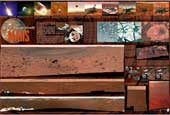
 |
|
|
|
Richard Schmude’s passion for astronomy, and the chemistry of comets in particular, brings to the table a book that covers almost every point in the comet observer’s arsenal. Kicking off with an overview of standard naming nomenclature, he deftly moves into a review of the laws of orbital mechanics, without diving too deeply into the mathematics, and in a way in that everyone should easily grasp. Sungrazers and short/long period comets are clearly explained, in terms of their physical and orbital characteristics, before a thorough overview of their chemical and physical composition and how their characteristic tails are formed. Recent impact events observed by amateurs also give this book a down to earth and contemporary feel, before launching into a detailed analysis of several more famous cometary encounters, including a personal favourite in the Deep Impact mission to Tempel 1. In these sections, Schmude does dive into some heavier treatments of comet structure, composition and orbital data, but then brings it back into perspective with wonderful analogies with known objects. He does this not only for Tempel 1, but also Halley, Wild 2 and Borrelly, but stick with it, you’ll learn a lot! Moving onto visual observations, Schmude covers a topic close to my heart, one of brightness and magnitude estimation. After the recent 103P debacle where visual and photometric measurements were showing wild fluctuations in magnitude values, this is a very good treatise and explanation as to why that happened. The almost obligatory overview of telescopes/seeing and optics then fills up a good few pages. What was surprisingly missing was a lack of discussion of in-depth imaging methods, in particular the use of things like rotational gradient processing (admittedly a potentially risky technique if not used correctly) for examination of the tail/inner coma and for assisting in measuring things like rotation speed, successfully done recently on 103P by many amateurs. In fact imaging, apart from a few well presented examples, gets short shrift in this book. The book is satisfying in many ways, filling in gaps in my knowledge in a way that kept me reading, despite the plethora of equations and values, but ultimately it left me wanting more. That said it is a very useful companion to any comet observer, and one that should find its way into the library of any university course or student of these most magical cosmic interlopers. A recommended read indeed, but one in which I hope a second edition covers more of the art and science of imaging. Nick Howes |
|
|
|
2009 Yearbook This 132-page special edition features the ultimate observing guide for 2009, a review of all the biggest news stories of 2008, in depth articles covering all aspects of astronomy and space missions for 2009, previews of International Year of Astronomy events and much, much more. This 132-page special edition features the ultimate observing guide for 2009, a review of all the biggest news stories of 2008, in depth articles covering all aspects of astronomy and space missions for 2009, previews of International Year of Astronomy events and much, much more.Infinity Rising  This special publication features the photography of British astro-imager Nik Szymanek and covers a range of photographic methods from basic to advanced. Beautiful pictures of the night sky can be obtained with a simple camera and tripod before tackling more difficult projects, such as guided astrophotography through the telescope and CCD imaging. This special publication features the photography of British astro-imager Nik Szymanek and covers a range of photographic methods from basic to advanced. Beautiful pictures of the night sky can be obtained with a simple camera and tripod before tackling more difficult projects, such as guided astrophotography through the telescope and CCD imaging.Exploring Mars  Astronomy Now is pleased to announce the publication of Exploring Mars. The very best images of Mars taken by orbiting spacecraft and NASA's Spirit and Opportunity rovers fill up the 98 glossy pages of this special edition! Astronomy Now is pleased to announce the publication of Exploring Mars. The very best images of Mars taken by orbiting spacecraft and NASA's Spirit and Opportunity rovers fill up the 98 glossy pages of this special edition!Mars rover poster  This new poster features some of the best pictures from NASA's amazing Mars Exploration Rovers Spirit and Opportunity. This new poster features some of the best pictures from NASA's amazing Mars Exploration Rovers Spirit and Opportunity. |
||||||||||||||||||||||||